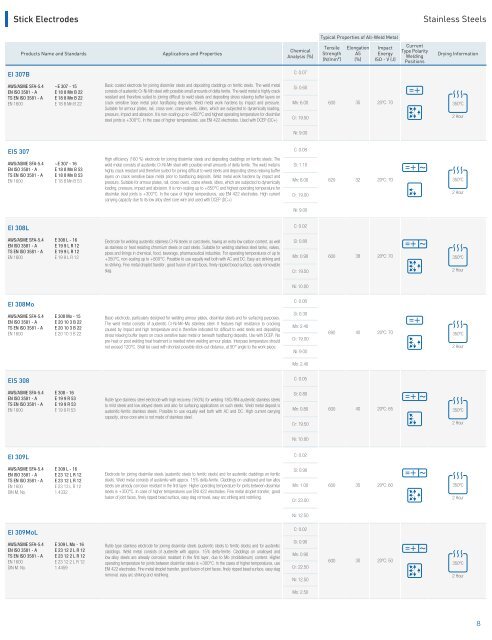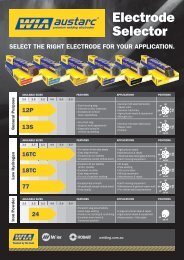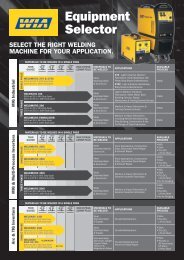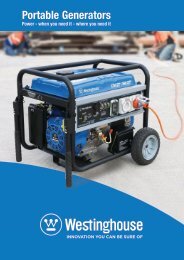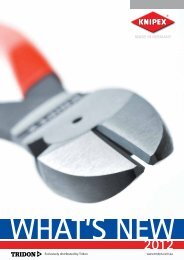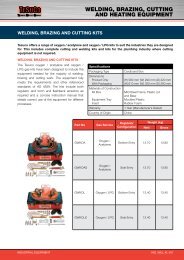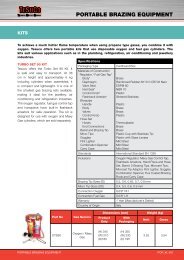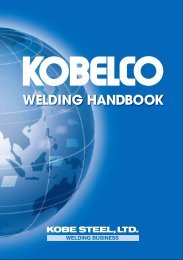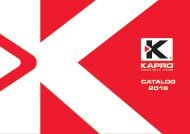Magmaweld Electrodes
Magmaweld Electrodes
Magmaweld Electrodes
You also want an ePaper? Increase the reach of your titles
YUMPU automatically turns print PDFs into web optimized ePapers that Google loves.
Stick <strong>Electrodes</strong><br />
Stainless Steels<br />
Typical Properties of All-Weld Metal<br />
Products Name and Standards Applications and Properties<br />
Tensile Elongation Impact<br />
Current<br />
Chemical<br />
Type Polarity<br />
Strength A5 Energy<br />
Analysis (%)<br />
Welding<br />
(N/mm²) (%) ISO - V (J)<br />
Positions<br />
Drying Information<br />
EI 307B<br />
AWS/ASME SFA-5.4<br />
EN ISO 3581 - A<br />
TS EN ISO 3581 - A<br />
EN 1600<br />
~E 307 - 15<br />
Basic coated electrode for joining dissimilar steels and depositing claddings on ferritic steels. The weld metal<br />
E 18 8 Mn B 22 consists of austenitic Cr-Ni-Mn steel with possible small amounts of delta ferrite. The weld metal is highly crack<br />
Si: 0.60<br />
E 18 8 Mn B 22 resistant and therefore suited to joining difficult to weld steels and depositing stress relaxing buffer layers on<br />
E 18 8 Mn B 22 crack sensitive base metal prior hardfacing deposits. Weld metal work hardens by impact and pressure.<br />
Suitable for armour plates, rail, cross-over, crane wheels, idlers, which are subjected to dynamically loading,<br />
Mn: 6.00 600 35 20ºC: 70 350ºC<br />
pressure, impact and abrasion. It is non-scaling up to +850°C and highest operating temperature for dissimilar<br />
steel joints is +300°C. In the case of higher temperatures, use ENI 422 electrodes. Used with DCEP (DC+)<br />
Cr: 19.50<br />
2 Hour<br />
C: 0.07<br />
Ni: 9.00<br />
EIS 307<br />
AWS/ASME SFA-5.4<br />
EN ISO 3581 - A<br />
TS EN ISO 3581 - A<br />
EN 1600<br />
High efficiency (160 %) electrode for joining dissimilar steels and depositing claddings on ferritic steels. The<br />
weld metal consists of austenitic Cr-Ni-Mn steel with possible small amounts of delta ferrite. The weld metal is<br />
highly crack resistant and therefore suited for joining difficult to weld steels and depositing stress relaxing buffer<br />
~E 307 - 16<br />
Si: 1.10<br />
E 18 8 Mn B 53<br />
E 18 8 Mn B 53<br />
E 18 8 Mn B 53<br />
layers on crack sensitive base metal prior to hardfacing deposits. Weld metal work hardens by impact and<br />
Mn: 6.00 620 32 20ºC: 70 350ºC<br />
pressure. Suitable for armour plates, rail, cross-overs, crane wheels, idlers, which are subjected to dynamically<br />
loading, pressure, impact and abrasion. It is non-scaling up to +850°C and highest operating temperature for<br />
dissimilar steel joints is +300°C. In the case of higher temperatures, use ENI 422 electrodes. High current<br />
carrying capacity due to its low alloy steel core wire and used with DCEP (DC+)<br />
C: 0.08<br />
Cr: 19.00<br />
2 Hour<br />
Ni: 9.00<br />
EI 308L<br />
AWS/ASME SFA-5.4<br />
EN ISO 3581 - A<br />
TS EN ISO 3581 - A<br />
EN 1600<br />
E 308 L - 16<br />
Electrode for welding austenitic stainless Cr-Ni steels or cast steels, having an extra low carbon content, as well Si: 0.80<br />
E 19 9 L R 12<br />
as stainless or heat resisting chromium steels or cast steels. Suitable for welding stainless steel tanks, valves,<br />
re-striking. Fine metal droplet transfer, good fusion of joint faces, finely rippled bead surface, easily removable<br />
E 19 9 L R 12<br />
pipes and linings in chemical, food, beverage, pharmaceutical industries. For operating temperatures of up to<br />
E 19 9 L R 12 +350°C, non-scaling up to +800°C. Possible to use equally well both with AC and DC. Easy arc striking and<br />
Mn: 0.90 600 38 20ºC: 70<br />
slag.<br />
Cr: 19.50<br />
C: 0.02<br />
350ºC<br />
2 Hour<br />
Ni: 10.00<br />
EI 308Mo<br />
AWS/ASME SFA-5.4<br />
EN ISO 3581 - A<br />
TS EN ISO 3581 - A<br />
EN 1600<br />
Si: 0.30<br />
E 308 Mo - 15<br />
Basic electrode, particularly designed for welding armour plates, dissimilar steels and for surfacing purposes.<br />
E 20 10 3 B 22 The weld metal consists of austenitic Cr-Ni-Mn-Mo stainless steel. It features high resistance to cracking<br />
E 20 10 3 B 22<br />
Mn: 2.40<br />
caused by impact and high temperature and is therefore indicated for difficult to weld steels and depositing<br />
E 20 10 3 B 22 690 40 20ºC: 70<br />
stress relaxing buffer layers on crack sensitive base metal or beneath hardfacing deposits. Use with DCEP. No<br />
pre-heat or post welding heat treatment is needed when welding armour plates. Interpass temperature should<br />
Cr: 19.00<br />
not exceed 120°C. Shall be used with shortest possible stick-out distance, at 90° angle to the work piece.<br />
Ni: 9.00<br />
C: 0.08<br />
Mo: 2.40<br />
350ºC<br />
2 Hour<br />
EIS 308<br />
AWS/ASME SFA-5.4<br />
EN ISO 3581 - A<br />
TS EN ISO 3581 - A<br />
EN 1600<br />
E 308 - 16<br />
Si: 0.80<br />
E 19 9 R 53<br />
Rutile type stainless steel electrode with high recovery (160%) for welding 18Cr/8Ni austenitic stainless steels<br />
capacity, since core wire is not made of stainless steel.<br />
E 19 9 R 53<br />
to mild steels and low alloyed steels and also for surfacing applications on such steels. Weld metal deposit is<br />
E 19 9 R 53 austenitic-ferritic stainless steels. Possible to use equally well both with AC and DC. High current carrying<br />
Mn: 0.80 600 40 20ºC: 65<br />
Cr: 19.50<br />
C: 0.05<br />
350ºC<br />
2 Hour<br />
Ni: 10.00<br />
EI 309L<br />
C: 0.02<br />
AWS/ASME SFA-5.4<br />
EN ISO 3581 - A<br />
TS EN ISO 3581 - A<br />
EN 1600<br />
DIN M. No.<br />
E 309 L - 16<br />
E 23 12 L R 12<br />
E 23 12 L R 12<br />
E 23 13 L R 12<br />
1.4332<br />
Electrode for joining dissimilar steels (austenitic steels to ferritic steels) and for austenitic claddings on ferritic<br />
steels. Weld metal consists of austenite with approx. 15% delta-ferrite. Claddings on unalloyed and low alloy<br />
steels are already corrosion resistant in the first layer. Higher operating temperature for joints between dissimilar<br />
steels is +300°C. In case of higher temperatures use ENI 422 electrodes. Fine metal droplet transfer, good<br />
fusion of joint faces, finely ripped bead surface, easy slag removal, easy arc striking and restriking.<br />
Si: 0.90<br />
Mn: 1.00<br />
Cr: 23.00<br />
600 35 20ºC: 60<br />
350ºC<br />
2 Hour<br />
Ni: 12.50<br />
EI 309MoL<br />
C: 0.02<br />
AWS/ASME SFA-5.4<br />
EN ISO 3581 - A<br />
TS EN ISO 3581 - A<br />
EN 1600<br />
DIN M. No.<br />
E 309 L Mo - 16<br />
E 23 12 2 L R 12<br />
E 23 12 2 L R 12<br />
E 23 12 2 L R 12<br />
1.4459<br />
Rutile type stainless electrode for joining dissimilar steels (austenitic steels to ferritic steels) and for austenitic<br />
claddings. Weld metal consists of austenite with approx. 15% delta-ferrite. Claddings on unalloyed and<br />
low-alloy steels are already corrosion resistant in the first layer, due to Mo (molibdenum) content. Higher<br />
operating temperature for joints between dissimilar steels is +300°C. In the cases of higher temperatures, use<br />
ENI 422 electrodes. Fine metal droplet transfer, good fusion of joint faces, finely ripped bead surface, easy slag<br />
removal, easy arc striking and restriking.<br />
Si: 0.90<br />
Mn: 0.90<br />
Cr: 22.50<br />
Ni: 12.50<br />
600 30 20ºC: 50<br />
350ºC<br />
2 Hour<br />
Mo: 2.50<br />
8


